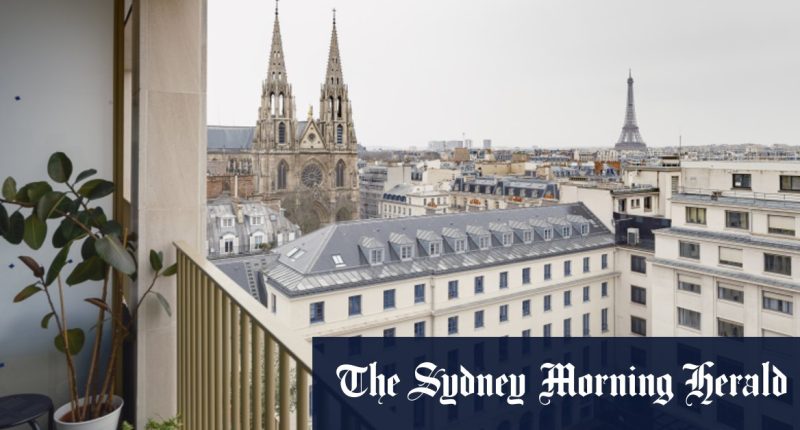The two-bedroom penthouse comes with sweeping views of the Eiffel Tower and just about every other monument across the Paris skyline.
The rent, at €600 ($1000) a month, is a steal.
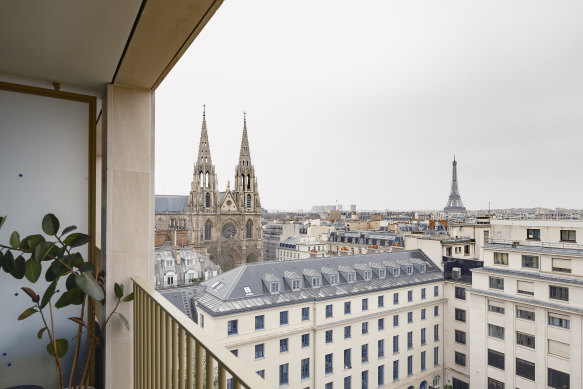
A view of the Eiffel Tower from an apartment in the Îlot Saint-Germain public housing development in Paris.Credit: Alex Cretey-Systermans/The New York Times
Marine Vallery-Radot, 51, the apartment’s tenant, said she cried when she got the call last northern summer that hers was among 253 lower-income families chosen for a spot in the l’Îlot Saint-Germain, a new public-housing complex a short walk from the Musée d’Orsay, the National Assembly and Napoleon’s tomb.
“We were very lucky to get this place,” said the single mother who lives here with her 12-year-old son, as she gazed out of bedroom windows overlooking the Latin Quarter. “This is what I see when I wake up.”
“Those who produce the riches of the city must have the right to live in it.”
Ian Brossat, Paris Council head of housing
Public housing can conjure images of bleak, boxy towers on the outskirts of a city, but this logement social was built in the former offices of the French Defence Ministry, in the 7th arrondissement, one of Paris’ most chic neighbourhoods. It’s part of an ambitious and aggressive effort to keep middle and lower-income residents and small-business owners in the heart of a city that would otherwise be unaffordable to them, and by extension, to preserve the ineffable character of a city adored by people around the world.
This summer, when the French capital welcomes upwards of 15 million visitors for the Olympic Games, it will showcase a city engineered by government policies to achieve mixité sociale – a diverse social mix. One-quarter of all Paris residents now live in public housing, up from 13 per cent in the late 1990s. The mixité sociale policy, promoted most forcefully by left-wing political parties, notably the French Communist Party, targets the economic segregation seen in many world cities.
“Our guiding philosophy is that those who produce the riches of the city must have the right to live in it,” said Ian Brossat, a communist senator who served for a decade as the Paris Council’s head of housing. Teachers, sanitation workers, nurses, college students, bakers and butchers are among those who benefit from the program.
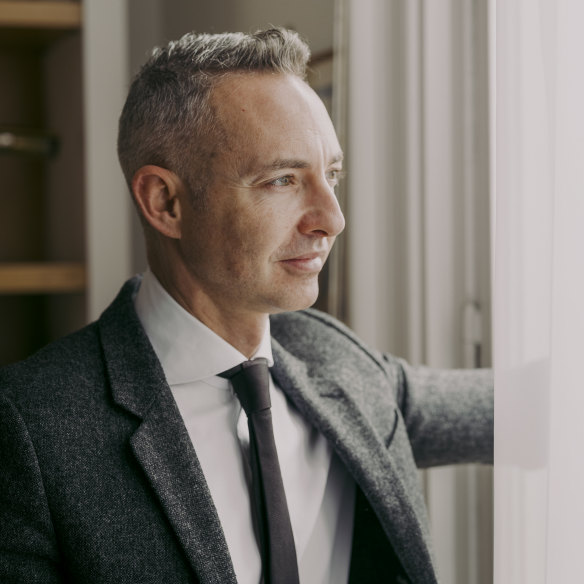
Ian Brossat, a communist senator who served for a decade as Paris Council’s head of housing.Credit: Alex Cretey-Systermans/The New York Times
Making the philosophy a reality is increasingly hard – the waitlist for public housing in Paris is more than six years long. “I won’t say this is easy and that we have solved the problem,” Brossat said.
Paris is being buffeted by the same market forces vexing other so-called superstar cities such as London, San Francisco and New York – a sanctum for the world’s wealthiest to park their money and buy a piece of a living museum. The average price for a 90-square-metre apartment in the centre of the capital today is €1.3 million ($2.16 million), according to the Chamber of Notaries of Paris.
The Abbé Pierre Foundation, an influential charity, was unusually emphatic in its annual report, published in February, calling France’s affordability crisis a “social bomb”: homelessness is rising and 2.4 million families are waiting on public-housing applications, up from 2 million in 2017. Still, the measures that Paris has taken to keep lower-income residents in the city go far beyond the initiatives in most other European cities.
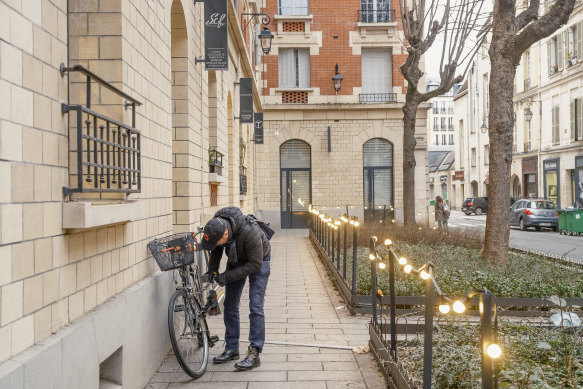
The city converted La Caserne des Minimes, a police barracks built during the French Revolution, into 70 public housing units.Credit: Alex Cretey-Systermans/The New York Times
Every Thursday, Jacques Baudrier, the Paris city councillor in charge of housing, scrolls through the list of properties being exchanged by sellers and buyers on the private market. With some exceptions, the city has the legal right to preempt the sale of a building, buy the property and convert it to public housing.
“We are in a constant battle,” said Baudrier, who wields a €625 million annual budget.
The fight, he said, is against forces that make buying Parisian real estate impossible for all but the well-to-do, including buyers who snap up holiday apartments and then leave them empty for most of the year. Paris has also sharply restricted short-term rentals, after officials became alarmed when historic neighbourhoods, including the old Jewish quarter, the Marais, appeared to be shedding full-time residents as investors bought places to rent out to tourists.
At the same time, the city has built or renovated more than 82,000 apartments over the past three decades for families with children. Rents range from €6 to €13 per square metre, depending on household income, meaning that a two-bedroom, 90-square-metre apartment might go for as little as €600 a month. It has also built 14,000 student apartments over the past 25 years; monthly rents at one complex currently nearing completion in the 13th arrondissement start at €250.
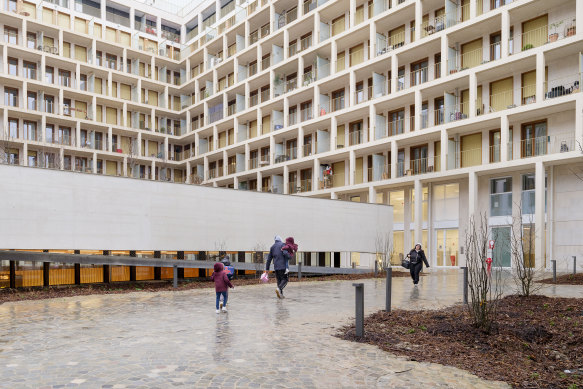
Îlot Saint-Germain public housing development in Paris.Credit: Alex Cretey-Systermans/The New York Times
The French statistics agency, Insee, reports that Paris is home to more than 10,000 nurses, 1700 bakers, 470 butchers, 945 garbage collectors and 5300 janitors. The push for more social housing and other programs to make the city more affordable has coincided with the dominance of left-wing political parties, who came to power in 2001 after decades of right-wing rule.
But François Rochon, an urban planning consultant, said there is a functional consensus between right and left in France today on the need for public housing that mirrors some other European nations, but not the United States. “Living in social housing is not stigmatised,” said Rochon, who pointed to its roots a century ago in France, when companies built apartments for their workers.
As a measure of the left-right alignment on the issue, Benoist Apparu, a former housing minister who served in a conservative government, described social housing as “absolutely essential”.
Loading
“A city, if it’s only made up of poor people, is a disaster,” said Apparu, who now works for a property developer. “And if it’s only made up of rich people, it’s not much better.”
Paris’ housing program is part of the trade-off of the welfare state: affordable healthcare and education in exchange for some of the highest income tax rates and social charges in Europe. Public housing, however, is increasingly available only for those lucky enough to get it.
There also is vestigial cynicism in Paris about public housing after a series of scandals in the 1990s, when some conservative politicians were revealed to be paying cheap rents for luxury city-owned apartments. Today, the city awards public housing through a system that strips the names of applicants and prioritises them through a points system that factors income and family circumstances.
Mostly, resistance comes at the local level, Rochon said. Residents in central arrondissements, for example, have often pushed back against building public housing, and the neighbourhoods remain bastions of the wealthy. There is also disagreement about how far the government can or should push public housing in the future. The current goal is for Paris to have 30 per cent public housing for low-income residents and 10 per cent for middle-income residents by 2035.
Baudrier, the Paris City Council member, said he believes that in the long term, 60 per cent of housing in the city should be public and reserved for low- and middle-income families.
But building new public housing has been particularly challenging because so much of the city is already so densely packed – and often protected by landmark status.
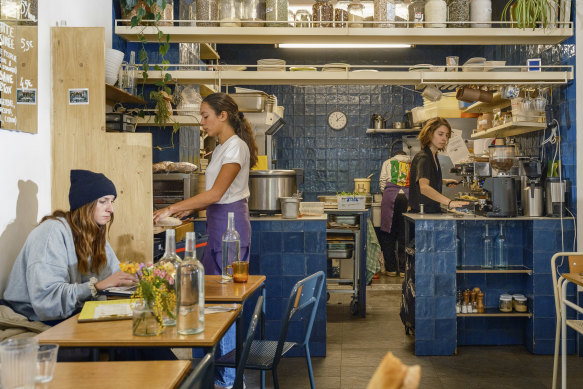
Desirée Fleurs, a business that sells coffee and flowers grown locally, in a storefront rented by the city of Paris.
The city extends its mixed social policy to help small business stay in the city.Credit: Alex Cretey-Systermans/The New York Times
City planners have negotiated with the public railways to buy old train yards and rights of way. They’ve also seized on opportunities like the one that arose in 2018, when the French Defence Ministry consolidated its offices in Paris and the city negotiated to buy the l’Îlot Saint-Germain for well below market rates. The ensuing construction of 253 apartments was financed by the sale of part of the building to a Qatari investment fund, which is building a luxury hotel, as well as low-interest government loans that have durations as long as 50 to 80 years, according to Emmanuelle Cosse, a former housing minister.
City Hall has also taken over condemned buildings. Fabrice Chaillou, a father of two who manages computer networks, lives in public housing on the northern edge of Paris that was built from the ruins of a dilapidated neighbourhood. He pays €980 a month for a three-bedroom apartment that he waited 10 years to get. Among his neighbours are a janitor, teachers, a car salesperson and a police officer.
The program has allowed Chaillou and his wife to raise their two boys in the city. But he knows that the future of social housing will always face at least one big challenge: “The problem is that once you get in, you never want to leave.”
This article originally appeared in The New York Times.
Get a note directly from our foreign correspondents on what’s making headlines around the world. Sign up for the weekly What in the World newsletter here.
Also Read More: World News | Entertainment News | Celebrity News
